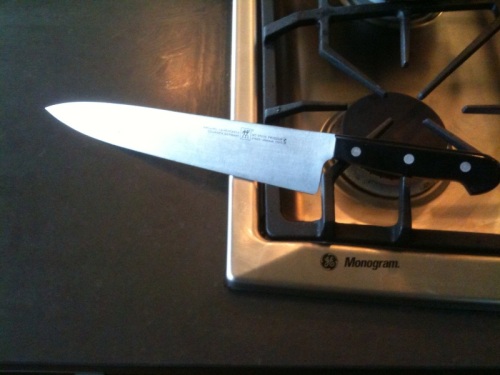So I said that I would be better. I am not a notorious breaker of promises—at least I think I’m not—but it’s been a longer lapse again than I would like. It’s hard to believe we’re already through two of our five stations for the first quarter, but the good news is, what started as a weary blur has now tempered into a reliable hum. This is what your life is like now. I will tell you, after nearly a year of being on my own, and unemployed, and setting my own schedule, this has truly taken some getting used to. I get up in the dark, I drive to school in the dark, I eat lunch at 9:45am, I spend the day in a windowless kitchen. My time is no longer my own. I miss that a lot, truth be told, and looking back on it, I can hardly imagine it was a full year. Trust me, it goes a lot faster than you think.
But here we are, a month into school. It’s starting to smell like winter outside, a heady mixture of cold, damp air and rotting leaves. No matter how fast this first month has gone, I have come to realize that this is a long haul—slightly longer than the time I’ve had at home—and that has its own brand of expectation to manage. This is what your life is like now.
I’ve had a lot of people ask me a variation on the same question in the last week: What’s the best thing you’ve learned so far in school? I wish I had some fabulously culinarian answer to wow you with—like the professional secret to a fabulous beurre noisette sauce, or the technique for an amazing French onion soup. Truth is, I haven’t done much cooking in the last few weeks. Week Two was the second week of Prep 1. (Sorry for all of the numbers, but it’s the way the school uses to keep track of all of us, and it becomes second nature after a while.) It pretty much takes two weeks in a station to get your act together—to figure out where everything is, to figure out who wants to learn and who is just taking up real estate in the kitchen, to figure out who has something to teach you and who can’t be bothered—and then you’re booted somewhere new. By second quarter, when you start repeating some stations as a “Two” (we newbies are referred to as “Ones,” and so on—your quarter is your shorthand), I’m sure it all starts to sing. But for now, it’s a little jarring. This is what your life is like now.
For Weeks Three and Four, I was sent to the Inventory station, along with six other Ones. Hear that? That is the collective moaning and groaning from most of the culinary student body upon hearing they’ve been sentenced to two weeks in Inventory. Stuck in “The Cage”—the meshed-in storeroom where all of the kitchen’s stocked items and walk-in coolers and freezer reside before they get shipped out to the kitchen for active duty—you’d think they were a bunch of depressed zoo creatures, noses pressed to the glass, just begging to be let out. Oh no, you’re in Inventory? That sucks. Sorry, man.
Wanna know this week’s dirty little secret, the one that will earn me scorn and hateful looks from the rest of the student body? I love Inventory. Partly because it’s the first thing I’ve done here that I have truly never, ever done before, and can’t really learn on my own from a cookbook. But mostly because what I really love, aside from the stocks and the sauces and the gratins and the terrines, is learning what makes a particular business tick, and how to make it better. Though I’ve been working as a designer for the past fifteen years, the business parts of it compared with the restaurant industry aren’t all that different: Both are service professions, albeit with different end products and a different client base. But the principles are the same, and it’s in my comfort zone, which is the first time I’ve said that in over a month. This is what your life is like now.
All of the whining and moaning, of course, comes from the people who just want to cook. This station sucks, man, I should be in the kitchen. I don’t care about this—I’m here to learn how to cook. The rude awakening for these kids—and they are kids, most of them between eighteen and twenty-five—is that working on a kitchen line for twenty years will break you. It will kill your back, your knees, your feet. And if the constant adrenaline rush of service doesn’t drain you—because the low always follows the high—then the hard-playing, drink-til-dawn-and-show-up-hungover lifestyle will. One day it stops being a badge of honor and just starts being what wears you down.
It’s amazing to me how many of these guys (and they are mostly guys—most of the girls are making bread and chocolate across the way in the brand-new pastry building) idolize Anthony Bourdain and his tales of heroin and attitude. Don’t get me wrong, I love me some Tony—I read Kitchen Confidential and get all wanderlusty watching No Reservations. I even paid good money to see him sit on a stage a few months ago with Mario Batali and do nothing but chat about food. But the part that gets me is what he’s been able to do with his life after getting off the line. Hell, if I could travel and eat and make TV for a living, I’d be a cocky dude in cowboy boots too. But most likely he didn’t give up cooking on the line because he could make more money writing books. (Who makes more money writing books? Not so many people.)
He gave it up because cooking is a young person’s game, and at some point you have to move on—to be kitchen manager, executive chef, business owner, author, TV star. And part of what makes him so charming as a celebrity is that he’s got humility in spades—he knows how stupid he was, how headstrong and rude, how close he came to fucking up his own life for the last time. He is beyond grateful for where he is now—the fifty-three-year-old Tony who’s clean of heroin and has a new wife and a beautiful baby girl—compared to where he could have been. But these kids, right now, they’re all young Tony, all attitude and swagger. All they wanna do is cook, and you can’t cook in Inventory. Thus the mopey faces and dragging feet and black hole of motivation. They want to be Tony Fucking Bourdain. But to do that, you have to know your business, and some of that business happens outside the kitchen. Some of that business happens in The Cage.
So yes, I liked Inventory. Monday is shipment day, so that means when you walk in at 8am, your drivers from Charlie’s Produce or Food Services of America (aka FSA, fyi) or Pacific Seafood or Interbay Meats or Coca-Cola are lined up on the dock outside, ready to wheel in cart after cart of whatever will go into the kitchens that week. It’s fascinating really, with its own language and code and procedure—you can buy fennel individually, say, but you have to buy butternut squash by the case—and it’s about rectifying what the chefs requisitioned with what was actually ordered with what they tried to pack on your cart and get away with before you noticed. Thumb on the scale? Who, me?
Once everything is checked in, it all goes back out again: Requisitions get filled and produce and meat and dairy and dry goods get divvied up and rolled out to stations so the rest of the lucky bastards who don’t have to be in Inventory, where it sucks and I am clearly being punished, can actually cook something with it. Following that, what’s left in the storeroom—items needed later in the week, or for a special event menu, or simply as backup—gets priced, by the pound, by the individual item, by the case. Menu costing, something we didn’t get to do very much of but which totally and completely fascinates the project manager nerd in me, is quite literally a game of pennies, down to how much edible product a given item yields (for example, a strawberry yields a higher percentage of edible product than an orange) and how that affects costs. Makes you appreciate even more the “stock buckets” that collect vegetable scraps in every prep station, so that thirty percent waste on a butternut squash actually goes to good use.
And once all that is done, the deliveries on Mondays and the actual counting of inventory on Thursdays, the dreadfully boring part of Inventory starts. The part where you have to be self-directed and actually find something to do with your time. Given than there are student computer terminals in the back, this generally involves lots of Facebooking and playing of video games under the auspices of “research,” when not sleeping with one’s eyes open. Instead, those of us who wanted something to do (all of us over 35 and corporate-world refugees) found it ourselves: I used those fifteen years of commercial interior design experience to sketch up a new space plan and we reorganized the entire storeroom, down to printing new shelf tags and setting up product to—gasp!—actually match the order on the Inventory sheets. David, an ex-computer guy, cleaned up spreadsheets and created new ones. Diane, who has run two of her own businesses, cleaned out files and put whippersnappers to work folding about a thousand kitchen towels. It took us half a day to do what hadn’t gotten done with another group of students in almost three years. It was all in a (half) day’s work, but everyone else couldn’t understand why we were doing so much–after all, it’s just Inventory. But those of us who’ve been out in the “real world,” who’ve had jobs and careers and likely lost both, we know what works for us. As Diane said, “I didn’t come here to sit on my ass.” Somehow this is a shocking sentiment to these kids, who just want to know, Is this on the test? Will there be a quiz? Do I have to memorize this?
This is what your life is like now.
Ms. K, the fabulous woman who has run this part of the business at SSCC for close to thirty years, gets a lot of unnecessary grief for being the harbinger of storeroom doom. Even though she is effectively managing the kitchens of three independent businesses, and half a dozen more revenue centers, she is simply looked on as the woman who keeps me from cooking while I’m trapped in The Cage. It’s a bum rap. She’s whip smart, with decades of experience and a wicked sense of humor, and she has managed multi-million dollar budgets and staffs of 200-plus people. Plus if you feed her peanut M&Ms and the occasional venti caramel macchiato, she will be your biggest ally–and let you out of station to go get a coffee or send you down to the Garden Center to harvest fresh herbs while everyone else stays in The Cage. When we finished the storeroom project and walked her through what we had done, I thought she might literally levitate with joy. It was a little thing to us, but clearly meant the world to her that someone cared about her station, about what she had to teach. This is what your life is like now.
Have I mentioned that I loved Inventory?
So, what’s the best thing I’ve learned in this first month of culinary school? It’s not a recipe, or a technique, or a secret ingredient. It’s what I’m sure I’ve known all along, only now from the other side:
That age and experience will still outwit youth and treachery. (And indeed, there has been treachery. Another post for another time. Or buy me a stiff drink and I’ll tell you in person.)
That if you want something done, you have to do it yourself.
That people sometimes can’t hack it when you don’t go willingly into the box they want you in.
That at age twenty-five (or eighteen), you cannot possibly know as much about the world as you think you do.
That if you want to be Tony Bourdain, work on the humility, not the attitude.
That this world owes you nothing, and it will kick your ass and not look back.
This is what my life is like now. Next week, back to the kitchen.

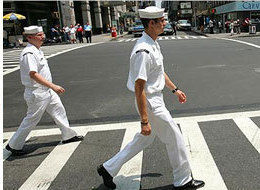 And, of course, any young woman (or gay man) who has ever lived in New York City can tell you the swoony appeal of Fleet Week. Suddenly, out of nowhere—like little spit-shined, dress-white rays of sunshine in a black, gritty, urban-dark sea of grouchy hipster city boys—the streets are full of clean-shaven men (and women, of course) set loose on a defenseless island. Many a young lass has been swept off her feet by the “yes ma’am, no ma’am” charm of a sailor on leave. Try that crap with a savvy New York girl without the uniform and you’d probably get a drink tossed in your face, or at the very least earn some scornful, mocking derision. In truth, most of those outfits aren’t even all that flattering—what grown man wants to look like the Pillsbury Doughboy in a little hat and jaunty tie?—but then, it really doesn’t matter, does it?
And, of course, any young woman (or gay man) who has ever lived in New York City can tell you the swoony appeal of Fleet Week. Suddenly, out of nowhere—like little spit-shined, dress-white rays of sunshine in a black, gritty, urban-dark sea of grouchy hipster city boys—the streets are full of clean-shaven men (and women, of course) set loose on a defenseless island. Many a young lass has been swept off her feet by the “yes ma’am, no ma’am” charm of a sailor on leave. Try that crap with a savvy New York girl without the uniform and you’d probably get a drink tossed in your face, or at the very least earn some scornful, mocking derision. In truth, most of those outfits aren’t even all that flattering—what grown man wants to look like the Pillsbury Doughboy in a little hat and jaunty tie?—but then, it really doesn’t matter, does it?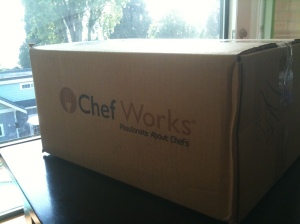 UPS guy arrived (look,
UPS guy arrived (look, 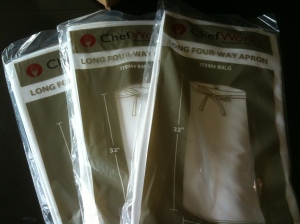

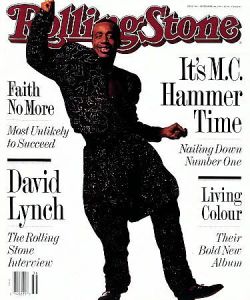
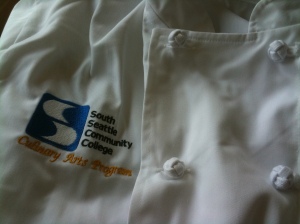
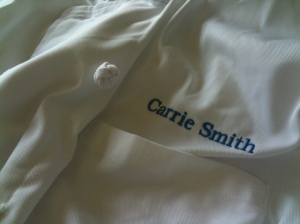

 This is Cappy, aforementioned resource on all things culinaire. Cappy and his fabulous wife, Kristie (no slouch in the kitchen herself, mind you), live on the East Coast, which is where we lived prior to Seattle–and which, no matter way you slice it, is too damn far away to live from fun people you adore. Cappy is a multi-talented guy who now makes his living running a company, doing software development and social media consulting, and writing books about Facebook. (No seriously, he and his business partner John just finished
This is Cappy, aforementioned resource on all things culinaire. Cappy and his fabulous wife, Kristie (no slouch in the kitchen herself, mind you), live on the East Coast, which is where we lived prior to Seattle–and which, no matter way you slice it, is too damn far away to live from fun people you adore. Cappy is a multi-talented guy who now makes his living running a company, doing software development and social media consulting, and writing books about Facebook. (No seriously, he and his business partner John just finished  To which I had no response, because I had no idea what the hell he was talking about. (Though I probably laughed anyway. I did that a lot in those days. God forbid I not know someone’s obscure reference and be called out for my shocking uncoolness, which would become immediately apparent.)
To which I had no response, because I had no idea what the hell he was talking about. (Though I probably laughed anyway. I did that a lot in those days. God forbid I not know someone’s obscure reference and be called out for my shocking uncoolness, which would become immediately apparent.) 